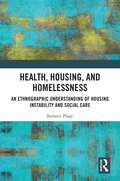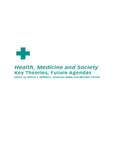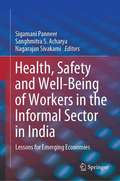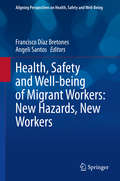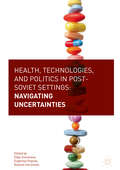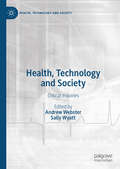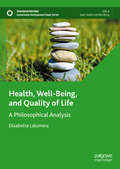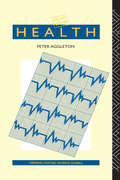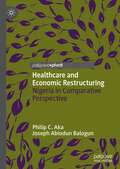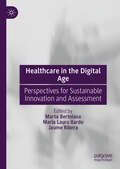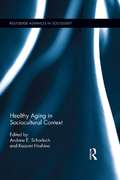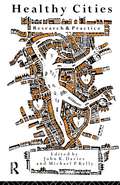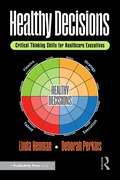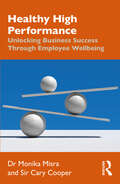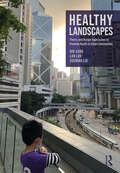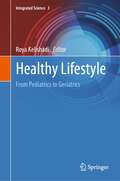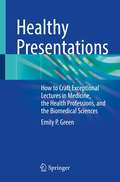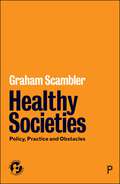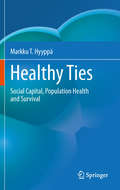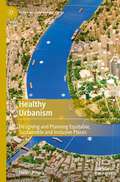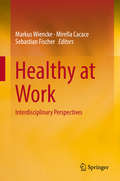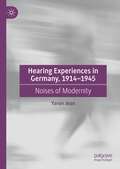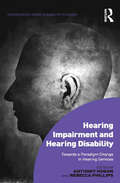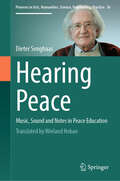- Table View
- List View
Health, Housing, and Homelessness: An Ethnographic Understanding of Housing Instability and Social Care
by Stefanie PlageExamining the fundamental relationship between housing and health, this perceptive volume illuminates how the health of those living with housing instability is affected by the day-to-day issues they face.Based on a series of interviews with both those affected by this issue and health and social care practitioners, as well as ethnographic observations at multiple sites of a health care centre, this book examines how housing instability shapes both the health services that people are able to access and their own approach to self-care. It highlights how housing instability is inextricably linked to poorer health outcomes, and suggests how individual, collective, and institutional practices can be reimagined to address the disparity between those with and without a stable home.This book will interest scholars and students across the Sociology of Health and Illness, Social Work, Public Health, and Social Policy, as well as practitioners in this field.
Health, Medicine and Society: Key Theories, Future Agendas
by Simon J. Williams Jonathan Gabe Michael CalnanTaking as its point of departure recent developments in health and social theory Health, Medicine and Society brings together a range of eminent, international scholars to reflect upon key issues at the turn of the century. Contributors draw upon a range of contemporary theories, both modernist and postmodernist, to look at the following themes: *health and social structure*the contested nature of the body*the salience of consumption and risk*the challenge of emotions Health, Medicine and Society provides a 'state-of-the-art' assessment of health related issues at the millennium and a cogent set of arguments for the centrality of health to contemporary social theory. Written in a clear, accessible style it will be ideal reading for students and researchers in health studies, public health, medical sociology, medicine and nursing.
Health, Safety and Well-Being of Workers in the Informal Sector in India: Lessons for Emerging Economies
by Sanghmitra S. Acharya Sigamani Panneer Nagarajan SivakamiThis book focuses on the core problems of occupational health, safety and well-being of workers in the informal sector in developing countries, where it accounts for most of the rural labour force and a substantial percentage of the urban labour force. The sector is characterised by low incomes, unstable employment and lack of protection in the form of legislation/policies or trade unions. Though some health and problem-solving measures have been introduced, a focused academic effort to address the problems confronting workers in the unorganised sector, or informal economy, is lacking.The book evaluates workers’ physical and mental health in the context of labour migration, social inclusion of minorities and the differently abled, provisions for women workers, demonetisation, occupational safety for hazardous work, and in connection with various areas of informal work, e.g. agriculture, construction, transportation, sanitation, tanning, the tobacco industry, powerloom industry, surrogacy, and self-employment. It provides a well-rounded description of an analytical reflection on the challenges these workers face and focuses on social policy changes to help alleviate them. Accordingly, it offers a valuable asset for researchers and students interested in development studies, the sociology of work, health and labour economics, public health, and social work.
Health, Safety and Well-being of Migrant Workers: New Hazards, New Workers (Aligning Perspectives on Health, Safety and Well-Being)
by Francisco Díaz Bretones Angeli SantosThis volume explores psychosocial problems amongst one of the most vulnerable social groups in our societies, immigrant workers, through a multidisciplinary approach. Migration has sometimes been oversimplified as a flow of workers from “poorer”, developing nations to “wealthier”, industrialised nations. The issue, however, is more complex and currently migration is a global phenomenon in which all countries are recipients of workers from third countries and send workers to third countries. The working conditions of immigrant workers at various levels are not always well known, though some studies have established that the negative impact on migrant workers is cumulative, and primarily stems from adverse living and working conditions in a new country and increased levels of vulnerability. The contributions to this volume cover discussions on migrant workers in the industrial, agricultural and service sectors across the world. They critically study the impact of work Hazards on the health and wellbeing of migrant workers in order to shed light on the social and health implications of migrant work, explore the relation between organizational, psychosocial and work factors, and analyse the migration process from a wider perspective and as a global phenomenon present in every country. The contributors provide multidisciplinary and multicultural contemporary perspectives, thereby providing readers with wide-ranging insights. This volume is of interest to researchers and students from the social and behavioural sciences, particularly those focusing on health studies and migration studies.
Health, Technologies, and Politics in Post-Soviet Settings
by Olga Zvonareva Evgeniya Popova Klasien HorstmanThis book uses a variety of empirical cases on topics including drug development, egg donation, and governance of healthcare facilities, to investigate how actors navigate the uncertainties that permeate the interfaces of health, technologies, and politics in post-Soviet settings and what the implications of their chosen navigation routes are. Contemporary societies are imbued with uncertainties, but the authors focus on settings where uncertainties multiply, making decisions, practises, and relations in everyday life precarious. Two worlds are brought into dialogue throughout the chapters of this book with the aim of facilitating mutual learning from one another - the world of science and technology studies (STS) and the high-income liberal democracies of the West, on one hand, and studies of post-socialism on the other. In so doing, this book encourages critical learning on ensuring the resilience of individual and societal health in situations of profound uncertainties. This timely collection will be of great interest to scholars, practitioners and policy makes in the fields of sociology, biomedicine, political science and public and global health.
Health, Technology and Society: Critical Inquiries (Health, Technology and Society)
by Sally Wyatt Andrew WebsterThis book celebrates and captures examples of the excellent scholarship that Palgrave’s Health, Technology, and Society Series has published since 2006, and reflects on how the field has developed over this time. As a collection of readings drawn from twenty-two books, it is organized around five themes: Innovation, Responsibility, Locus of Care, Knowledge Production, and Regulation and Governance. Structured in this way, the book gives the reader a concise but nonetheless rich guide to the core issues and debates within the field. Complementing these narratives, the original authors have provided new reflection pieces on their texts and on their current work. This then is a book which in part looks back but also looks forward to emerging issues at the intersection of health, technology, and society. It uniquely encompasses and presents a range of expertise in a novel way that is both timely and accessible for students and others new to the field.
Health, Well-Being, and Quality of Life: A Philosophical Analysis (Sustainable Development Goals Series)
by Elisabetta LalumeraThis book analyses and discusses from a philosophical perspective the concepts of health, well-being and quality of life in contemporary biomedical research. The guiding idea of the book is that different concepts of health, well-being, and quality of life lead to different types of projects, actions and policies, both at the individual and institutional level. For this reason, it is important to analyse them and make them clear, in their interweaving of objective dimensions (the facts) and evaluative dimensions (the values).
Health: Global Perspectives (Society Now)
by Peter AggletonWritten in a clear, accessible style, Health introduces students to the valuable contribution sociologists have made to understanding health, illness and disease. In so doing, it challenges the adequacy of biomedical models, contrasting them with explanations offered by positivist, interactionist, structuralist and feminist sociologists.Aggleton, an experienced teacher, links the key debates within the sociology of health and illness with their implications for health care, and covers topics such as complementary medicine and AIDS. Students are encouraged to undertake suggested activities and are given guidance for further reading to develop their understanding.
Healthcare Technology in Context: Lessons for Telehealth in the Age of COVID-19
by Alan TaylorThis book investigates how the technology used by telehealth services shapes our healthcare, and how we, as humans, collectively change and shape the technology and services used in healthcare. Based on extensive field research on telehealth services in Australia and Brazil, the book reveals some surprisingly obvious conclusions about our powers to shape the society.
Healthcare and Economic Restructuring: Nigeria in Comparative Perspective
by Philip C. Aka Joseph Abiodun BalogunThis book explores the intersection between healthcare delivery and national economic health, using Nigeria as case study and window into the world. Specifically, the issue this book tackles revolves around how to repair Nigeria’s dysfunctional healthcare system through the medium of a healthier economy that provides sufficient revenue to meet the healthcare needs of citizens.
Healthcare in the Digital Age: Perspectives for Sustainable Innovation and Assessment
by Jaume Ribera Marta Bertolaso Maria Laura IlardoThis book offers a comprehensive exploration of the dynamic relationship between digital technology and healthcare delivery, emphasising sustainable innovation in health services. It explores how digital technologies improve healthcare outcomes, enhance patient and community experiences, and streamline healthcare management, while addressing ethical, philosophical, and policy challenges tied to healthcare digitization. Examining trends such as telemedicine, AI diagnostics, data security, and the Internet of Medical Things (IoMT), the book highlights global case studies, lessons learned, and strategies for integrating these technologies sustainably. It discusses the contextual, economic, and social impacts of digital health, presenting frameworks for their evaluation and improvement. Advocating for regulatory policies that prioritise privacy, accessibility and enhance responsible initiative, the book calls for collaborative approaches. Aimed at healthcare professionals, policymakers, and academics, this resource provides insights into creating a more efficient and equitable healthcare system, aligning with the broader goals of public health and social justice.
Healthy Aging in Sociocultural Context: Healthy Aging In Sociocultural Context (Routledge Advances in Sociology #81)
by Andrew E. Scharlach Kazumi HoshinoHealthy Aging in Sociocultural Context examines two emerging trends facing countries throughout the world: population aging and population diversity. It makes a unique contribution to our understanding of these timely issues by examining their implications for healthy aging, a topic of increasing importance to policy-makers, planners, researchers, families, and individuals of all ages. The book focuses on three countries that provide important examples of these emerging global trends - Japan, Sweden, and the United States. Japan and Sweden are at the forefront in terms of healthy life expectancies, while the United States represents a country with considerable diversity. Examining these three countries together provides a unique opportunity to address questions such as the following: How can we understand differences in healthy life expectancy among different countries? What role might diversity play? And how might these effects change as geographic mobility increases diversity, even among societies that historically have been relatively homogeneous?
Healthy Cities: Research and Practice
by John K. Davies Michael P. KellyThe growth of health promotion as a topic for discussion and a principle for practice is widespread, and affects all groups of health professionals. The Healthy Cities project, like Health for All, was inaugurated by the World Health Organization and has informed policy throughout the world. Healthy Cities: Research and Practice examines the application of the project in a number of countries. The contributors explore problems in the relationship between policy makers, communities, and academic researchers, and discuss how the Healthy Cities program affects housing policy, community development, scientific interchange and health education. In addition, the Editors, John Davies and Michael Kelly, provide a context by tracing the history of the WHO projects and discuss them in the broader context of scientific and philosohical debates about modernism and post-modernism. The contributors are drawn from practitioners and scientists with wide experience in the area from the United Kingdom, Canada, Australia and the United States. Healthy Cities will be invaluable to all those working at community level and in government with an interest in health, as well as students of health promotion.
Healthy Decisions: Critical Thinking Skills for Healthcare Executives
by Linda Henman Deborah PerkinsIn the wake of an international pandemic, Healthy Decisions: Critical Thinking Skills for Healthcare Executives emerges as a crucial guide for leaders navigating the complex world of healthcare management. This thought-provoking book challenges the status quo, arguing that the success of healthcare organizations hinges not on abstract concepts like "culture," but on the concrete decisions executives make. Drawing from real-world experience with large systems like Mercy and Banner Health, specialty hospitals like Ranken Jordan Pediatric Bridge Hospital, insurance companies like Blue Cross Blue Shield, and nonprofit elder care systems, the authors provide a practical guide to help healthcare executives make the tough decisions they can’t afford to get wrong. With more than eight decades of combined consulting experience with diverse healthcare organizations, the authors present a compelling case for the paramount importance of decision-making in healthcare leadership. They argue that executives must embrace the messy, pragmatic reality of running healthcare organizations. This book offers a roadmap for healthcare leaders who want to move beyond vague discussions of culture and focus on the specific, high-stakes decisions that shape the climate of their organizations. Healthy Decisions offers a fresh perspective on organizational climate, asserting that it's shaped by a series of daunting decisions, not nebulous factors. The book provides invaluable insights into: The pitfalls of using "culture" as a convenient excuse for organizational failures The important role of well-developed analytical thinking skills in effective leadership Strategies for making difficult decisions more consistently, quickly, and accurately Real-world examples and research findings that illuminate the path to better decision-making The dispassionate thinking skills needed to assess risks and tradeoffs effectively How to inspire teams to embrace change, disruption, and innovation This essential roadmap equips healthcare executives with the tools to unlock their decision-making potential, avoid the traps of indecision, and ultimately improve the health of their organizations. Whether you're a seasoned healthcare leader or an aspiring executive, Healthy Decisions will transform your approach to leadership and organizational success in an increasingly uncertain world.
Healthy High Performance: Unlocking Business Success Through Employee Wellbeing
by Monika Misra Cary CooperThe Covid-19 pandemic, with its resulting lockdowns and significant changes to ways of working, has provided the opportunity to redefine the potential role that health and wellbeing can play within organisations.Empowering employees to work in ways that optimise their performance, acknowledging both personal and work demands, has created a new work paradigm that had previously not been considered. All savvy organisations will take this as a point in time to rethink business and HR practice, for the benefits of employees and employers. Written by the Head of Associate Health and Wellbeing (Europe) at Mars Incorporated, Dr Monika Misra, and world-renowned expert on wellbeing in organisations, Sir Cary Cooper, the book provides clear evidence of what worked well during the Covid-19 pandemic that we can learn from and embed today, to enable individuals and organisations to thrive. Basing recommendations on a robust evidence base and through real-life practices within organisations, they provide a framework for a four-level response at organisational, team, management and individual levels.This book will provide an essential resource to stimulate company leaders, managers and HR, to rethink and reframe new approaches that enhance employee wellbeing, engagement and performance.
Healthy Landscapes: Theory and Design Approaches to Promote Health in Urban Communities
by Bin Jiang Lan Luo Xueming LiuThis book responds to the need for a comprehensive and detailed theoretical framework and systemic design approaches to improve mental, physical, social, behavioral, and ecological health in urban environments.Although rapid urban development has created enormous economic and social value, it has also brought problems that have posed serious threats to the health of urban residents. Healthy Landscapes begins by reviewing practical experience, as well as theoretical and scientific evidence, from several related disciplines around the world. This is used to construct a provisional framework consisting of ten theoretical pathways for the environment to promote mental, physical,social, behavioral, and ecological health: Relieving mental stress; restoring direct attention; promoting environmental preference; promoting sublime and transcendent perceptions; promoting active lifestyles; preventing the spread of infectious diseases; promoting ecological services; enhancing social support; promoting the sense of belonging; and improving the sense of security. From these 24 theoretical pathways, the authors go on to identify 67 critical environmental characteristics for creating healthy communities, which are used to inform the design guidelines they go on to apply to community environment scenarios.This book will be an invaluable resource for students of landscape architectural design, architecture, and urban design. It will also be an essential tool for design professionals and urban administrators who want a comprehensive understanding of the fundamental theories of healthy communities with design guidelines supported by scientific evidence.
Healthy Lifestyle: From Pediatrics to Geriatrics (Integrated Science #3)
by Roya KelishadiThis book offers a comprehensive overview on lifestyle habits related to development of risk factors of chronic diseases. It provides a summary of the impacts of various modifiable factors that influence long-term health status. The accumulation of unhealthy lifestyle habits shows that over the life course, increasing the number, duration, and severity of unhealthy behaviors would increase the risk of disease development. This contributed volume highlights the fact that establishing a healthy lifestyle is easier and more effective than focusing on lifestyle change
Healthy Presentations: How to Craft Exceptional Lectures in Medicine, the Health Professions, and the Biomedical Sciences
by Emily P. GreenThis book is a practical guide for busy clinicians and educators within the biomedical sciences on how to improve their presentations. It includes specific, practical guidance on crafting a talk, tips on incorporating interactive elements to facilitate active learning, and before-and-after examples of improved slide design. Chapters discuss all aspects of exceptional presentations such as the identification of main concepts, organization of content, and best practices for creating lectures that are focused on the facilitation of learning rather than on passive information transfer. The examples provided are grounded in the biomedical sciences where presentations are necessarily dense and rich with critical content, making this book an essential read for anyone who lectures within a biomedical curriculum or presents at professional conferences. This book also addresses hot topics in medical education such as presenting on virtual platforms, and reviewing teaching materials for diversity, inclusion, and bias. These topics are not addressed in any other books on the market, and they address real gaps in medical and health professions training. Written from the perspective of an educator with over 20 years of experience in medical education, Healthy Presentations: How to Craft Exceptional Lectures in Medicine, the Health Professions, and the Biomedical Sciences recognizes the importance of high-quality, inclusive, and learner-centered presentations, and it provides essential guidance and support to the faculty who create them.
Healthy Societies: Policy, Practice and Obstacles (21st Century Standpoints)
by Graham ScamblerCan society be healthy, and how? Is Britain a ‘healthy society’ in the 21st century? When people ponder health, they usually consider the health of the individual, but individuals co-exist in a social environment so attention should be placed on the health of communities and populations. Re-examining health, healthcare and societal health using the latest data and research, this book provides a clear, accessible account of the current state of play. Addressing definitions of health in individuals, communities and populations, definitions of society itself, changes in health over time and the contribution of healthcare to health and longevity, it also suggests ways of effectively tackling obstacles to improving health and healthcare in 21st century Britain.
Healthy Ties
by Markku T. HyyppäSocial capital is a widely acknowledged candidate for implementing beneficial democratic processes and promoting public health. Healthy ties. Social capital, population health and survival traces the path from the conceptualization to the implementation of social capital. To provide empirical proof of the effects of social capital on public health is a serious challenge and the main focus of the book. In the Nordic countries, personal identification codes linking data from various sources, nation-wide population registers, nationally representative and re-tested health surveys, and the long tradition of epidemiology submit to serve well the research into social capital and public health. Up-to-date longitudinal data on social capital and health outcomes are carefully described and reviewed in this book. In Finland, the Swedish-speaking minority is very long-lived and has better health as compared with the Finnish-speaking majority.
Healthy Urbanism: Designing and Planning Equitable, Sustainable and Inclusive Places (Planning, Environment, Cities)
by Helen PineoThe globally distributed health impacts of environmental degradation and widening inequalities require a fundamental shift in understandings of healthy urbanism. This book redefines the meaning and form of healthy urban environments, urging planners and design professionals to consider how their work impacts population health and wellbeing at multiple spatial and temporal scales. The concepts of equity, inclusion and sustainability are central to this framing, reversing the traditional focus on individuals, their genes and ‘lifestyle choices’ to one of structural factors that affect health. Integrating theory and concepts from social epidemiology, sustainable development and systems thinking with practical case studies, this book will be of value for students and practitioners.
Healthy at Work
by Sebastian Fischer Markus Wiencke Mirella CacaceThis book aims at exploring the link between corporate and organizational culture, public and private policy, leadership and managerial skills or attitudes, and the successful implementation of work-related healthcare in Europe. Therefore it brings together a wide range of empirical and theoretical contributions from occupational health, management, psychology, economics, and (organizational) sociology to address the question of how to sustainably promote occupational health. Such important questions are answered as: What aspects of a corporate culture can be associated with health issues? How does leadership style affect the health of employees? How are health-related decisions in the workplace affected by the political environment? To what extent are interventions influenced by corporate culture, leadership and public policy? How can we make such interventions sustainable?
Hearing Experiences in Germany, 1914–1945: Noises of Modernity
by Yaron JeanThis book tells the story of Germany between the years 1914–1945 through the history of its sounds and noises. From the killing grounds of the Great War, passing through the roaring optimism of the 1920s, and up to the horrifying spectacle of the Nazis and the dreadful apocalypse of the Second World War, sound became the epitaph of an era that was mostly dominated by war and a global sense of crisis. Yaron Jean reconstructs and analyses these moments when sound and its meaning became history, and places them in a single study that provides a unique perspective on the history of modern Germany in one of its most turbulent centuries.
Hearing Impairment and Hearing Disability: Towards a Paradigm Change in Hearing Services (Interdisciplinary Disability Studies)
by Rebecca Phillips Anthony HoganThe purpose of this book is to challenge people (service providers, people with a hearing disability and those who advocate for them) to reconsider the way western society thinks about hearing disability and the way it seeks to 'include them’. It highlights the concern that the design of hearing services is so historically marinated in ableist culture that service users often do not realise they may be participating in their own oppression within a phono-centric society. With stigma and marginalisation being the two most critical issues impacting on people with hearing disability, Hogan and Phillips document both the collective and personal impacts of such marginality. In so doing, the book brings forward an argument for a paradigm shift in hearing services. Drawing upon the latest research and policy work, the book opens up a conceptual framework for a new approach to hearing services and looks at the kinds of personal and systemic changes a paradigm shift would entail.
Hearing Peace: Music, Sound and Notes in Peace Education (Pioneers in Arts, Humanities, Science, Engineering, Practice #36)
by Dieter SenghaasListening to peace. When social scientists, publicists and teachers approach the problem of peace, they pay special attention to the causes of violence and war. Recently, however, insights into the causes of peace have gained broad resonance. The question is which factors, individually and in their interaction, are sustainably conducive to peace. Aesthetic dimensions of a peace order, however, usually remain underexposed, although the problem of peace can be impressively conveyed through images of peace. The fact that the essays in this book explain that access to various dimensions of peace through musical and compositional contributions can also be illuminating: Which peace-relevant problems have composers addressed in their works? Striking examples are explained. They are all to be found in the offerings of classical, i.e. value-retaining music of the past five centuries. - A unique book on peace education - For teachers and students in peace research and in music studies - Written by one of the co-founders of peace research in Germany - A key background book for peace concerts - A musical appeal for peace
